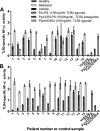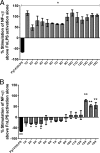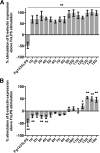Subgingival Plaque in Periodontal Health Antagonizes at Toll-Like Receptor 4 and Inhibits E-Selectin Expression on Endothelial Cells
- PMID: 26483407
- PMCID: PMC4694013
- DOI: 10.1128/IAI.00693-15
Subgingival Plaque in Periodontal Health Antagonizes at Toll-Like Receptor 4 and Inhibits E-Selectin Expression on Endothelial Cells
Abstract
The ability of the subgingival microbial community to induce an inappropriate inflammatory response ultimately results in the destruction of bone and gingival tissue. In this study, subgingival plaque samples from both healthy and diseased sites in the same individual were obtained from adults with chronic periodontitis and screened for their ability to either activate Toll-like receptor 2 (TLR2) or TLR4 and to antagonize TLR4-specific activation by agonist, Fusobacterium nucleatum LPS. Subgingival plaque from diseased sites strongly activated TLR4, whereas matched plaque samples obtained from healthy sites were significantly more variable, with some samples displaying strong TLR4 antagonism, while others were strong TLR4 agonists when combined with F. nucleatum LPS. Similar results were observed when TLR4 dependent E-selectin expression by endothelial cells was determined. These results are the first to demonstrate TLR4 antagonism from human plaque samples and demonstrate that healthy but not diseased sites display a wide variation in TLR4 agonist and antagonist behavior. The results have identified a novel characteristic of clinically healthy sites and warrant further study on the contribution of TLR4 antagonism in the progression of a healthy periodontal site to a diseased one.
Copyright © 2015, American Society for Microbiology. All Rights Reserved.
Figures





Similar articles
-
Analysis of the activity to induce toll-like receptor (TLR)2- and TLR4-mediated stimulation of supragingival plaque.J Periodontol. 2008 May;79(5):920-8. doi: 10.1902/jop.2008.070516. J Periodontol. 2008. PMID: 18454672
-
Induction of toll-like receptor expression by Porphyromonas gingivalis.J Periodontol. 2013 Jul;84(7):1010-8. doi: 10.1902/jop.2012.120362. Epub 2012 Sep 24. J Periodontol. 2013. PMID: 23003918
-
Analysis of Subgingival Plaque Ability to Stimulate Toll-Like Receptor 2 and 4.J Periodontol. 2016 Sep;87(9):1083-91. doi: 10.1902/jop.2016.150573. Epub 2016 May 23. J Periodontol. 2016. PMID: 27212110
-
Ability of supragingival plaque to induce toll-like receptor 4-mediated stimulation is associated with cytokine production by peripheral blood mononuclear cells.J Periodontol. 2009 Mar;80(3):512-20. doi: 10.1902/jop.2009.080393. J Periodontol. 2009. PMID: 19254136
-
Biological activities of lipopolysaccharides from oral bacteria and their relevance to the pathogenesis of chronic periodontitis.Sci Prog. 1995;78 ( Pt 1):19-34. Sci Prog. 1995. PMID: 7597416 Review.
Cited by
-
Effect of thymoquinone on Fusobacterium nucleatum‑associated biofilm and inflammation.Mol Med Rep. 2020 Aug;22(2):643-650. doi: 10.3892/mmr.2020.11136. Epub 2020 May 7. Mol Med Rep. 2020. PMID: 32626941 Free PMC article.
-
Periodontitis and cardiometabolic disorders: The role of lipopolysaccharide and endotoxemia.Periodontol 2000. 2022 Jun;89(1):19-40. doi: 10.1111/prd.12433. Epub 2022 Mar 4. Periodontol 2000. 2022. PMID: 35244966 Free PMC article. Review.
-
Toll-like receptor-4 activation by subgingival biofilm and periodontal treatment response.Clin Oral Investig. 2023 May;27(5):2139-2147. doi: 10.1007/s00784-023-04877-8. Epub 2023 Jan 31. Clin Oral Investig. 2023. PMID: 36719505
-
Does postcholecystectomy increase the risk of colorectal cancer?Front Microbiol. 2023 Jun 22;14:1194419. doi: 10.3389/fmicb.2023.1194419. eCollection 2023. Front Microbiol. 2023. PMID: 37426004 Free PMC article. Review.
-
The Effect of Oral Care Product Ingredients on Oral Pathogenic Bacteria Transcriptomics Through RNA-Seq.Microorganisms. 2024 Dec 23;12(12):2668. doi: 10.3390/microorganisms12122668. Microorganisms. 2024. PMID: 39770870 Free PMC article.
References
-
- Berezow AB, Ernst RK, Coats SR, Braham PH, Karimi-Naser LM, Darveau RP. 2009. The structurally similar, penta-acylated lipopolysaccharides of Porphyromonas gingivalis and Bacteroides elicit strikingly different innate immune responses. Microb Pathog 47:68–77. doi:10.1016/j.micpath.2009.04.015. - DOI - PMC - PubMed
-
- Coats SR, Berezow AB, To TT, Jain S, Bainbridge BW, Banani KP, Darveau RP. 2011. The lipid a phosphate position determines differential host Toll-like receptor 4 responses to phylogenetically related symbiotic and pathogenic bacteria. Infect Immun 79:203–210. doi:10.1128/IAI.00937-10. - DOI - PMC - PubMed
Publication types
MeSH terms
Substances
Grants and funding
LinkOut - more resources
Full Text Sources
Molecular Biology Databases

